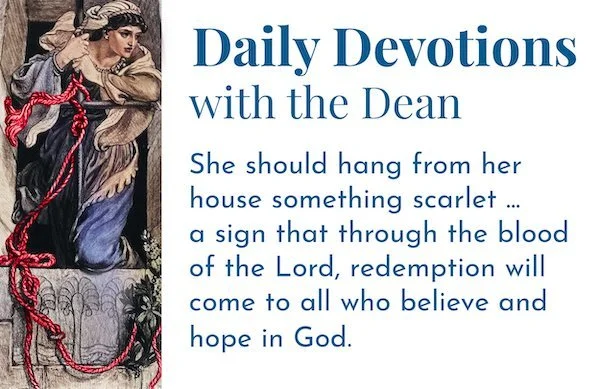Tuesday • 7/16/2024 •
Tuesday of Proper 10
This morning’s Scriptures are: Psalms 26 & 28; Joshua 2:15-24; Romans 11:13-24; Matthew 25:14-30
This morning’s Canticles are: following the OT reading, Canticle 13 (“A Song of Praise,” BCP, p. 90); following the Epistle reading, Canticle 18 (“A Song to the Lamb,” Revelation 4:11; 5:9-10, 13, BCP, p. 93)
We remain focused today on the Old Testament and the epistle readings. For your consideration, I want to offer observations from three ancient Christian interpreters. I realize that in some quarters of the church and the academy, these early voices don’t count for much. But in recent years, I have come to sense that the first generations of interpreters of Scripture are more attuned to the Bible’s own dense symbolic bandwidth.* Again, … for your consideration.
Image: Adaptation, Rahab hangs the scarlet cord from her window. Autotype after F.J. Shields, 1877. Frederic Shields , CC BY 4.0, via Wikimedia Commons
First, from Clement of Rome, who toward the end of the 1st century AD offers the first post-New Testament interpretation of the significance of Rahab. Combining perspectives from James 2:25 and Hebrews 11:31, Clement says: “Because of her faith and hospitality Rahab the harlot was saved” (1 Clement 12.1). Then, after recounting the Joshua narrative about Rahab hiding the Hebrew spies, misdirecting the Jericho king’s men, expressing her faith in Israel’s God, and receiving the spies’ instructions to gather her family under her roof when she sees the Israelites coming, Clement adds an extraordinary note:
And in addition, they gave her a sign (Gk., sēmeion), that she should hang from her house something scarlet—making it clear that through the blood of the Lord, redemption will come to all who believe and hope in God. You see, dear friends, not only faith but also prophecy is found in this woman (1 Clement 12:7-8).
Next, a half century later, in the middle of the 2nd century, also from Rome, Justin Martyr expands upon Clement’s offering the scarlet rope as a “sign” of the blood of Christ. Justin compares Rahab’s scarlet thread with the blood of the Passover lambs that had been sprinkled on the doorposts and lintels of Hebrew households during the exodus—another sign bringing deliverance from death. Justin draws this lesson:
For the sign of the scarlet thread … also manifested the symbol of the blood of Christ, by which those who were at one time harlots and evil persons out of all nations are saved, receiving remission of sins, and continuing to sin no longer (Dialogue with Trypho 111.4).
Finally, in the 3rd century AD, Origen of Alexandria sees Rahab not only prefiguring, by the scarlet thread, that “there was no salvation for man, save in the blood of Christ,” but forecasting also that it is only in one particular house, i.e., the Church, that that salvation is to be found.
She who was formerly a harlot receives this injunction: All who shall be found in thy house shall be saved … if anyone wishes to be saved, let him come into the house of her that was a harlot. Even if anyone of this people [that is, Jewish people] wishes to be saved, let him come into this house to obtain salvation. Let him come into this house in which the blood of Christ is the sign of redemption. Let there be no mistake, let no one deceive himself: outside this house, that is outside the Church there is no salvation (Third Homily 841C-842A).
This is the first time, as far as I know, that a phrase that is to become a hallmark of the early church appears: “outside the Church there is no salvation.” It all goes back, dare one say, to a whorehouse. What an amazing image for a call to church membership! Well, we won’t linger over that.
Then, as though Origen were following our own Daily Office lectionary, he embellishes his point by turning to Romans 11:13-24. Origen asserts that Rahab was one of those “wild branches” who, by God’s mercy and because of her faith, has been grafted into the trunk of the good olive tree, which is to say, she has become a true daughter of Abraham and citizen of the true Israel:
If you wish to understand more clearly how Rahab was incorporated into Israel, see how the branch of the wild olive is grafted onto the trunk of the good olive tree and you will understand how those who are grafted into the faith of Abraham, Isaac and Jacob are rightly said to be incorporated into Israel until this day. We [Origen is himself a gentile], branches of the wild olive tree, who were prostitutes adoring wood and stone instead of the true God, we have been truly incorporated into this root until this day (Preface to the Psalms 860C).
Origen’s invitation for Jewish people to “come into this house” of which the pagan harlot Rahab’s house is a picture (above), is, then, perfectly in line with Paul’s hope that his fellow Jews will one day no longer “persist in unbelief,” but rather, embrace Jesus as Messiah and see “God[‘s] … power to graft them in again.”
Lessons for today:
Whether the Lord originally intended for his church to see the prophecy of Jesus’s blood in Rahab’s scarlet rope, our brothers and sisters saw it there from the earliest days of New Testament interpretation. Regardless, that blood—and that blood alone—saves from a cataclysm even more devastating than the destruction of Jericho: the judgment of the world.
It is indeed into a single house—the church universal that God is building, with Christ Jesus as cornerstone and his apostles and prophets as foundation (Ephesians 2:20)—that the Lord is calling all his people. When we work and pray and teach towards “one Lord, one faith, one baptism” (Ephesians 4:5), we are cooperating with one of the Bible’s deepest and oldest truths.
Finally, we will never exhaust the mercies of the kind of God who redeems spiritual and literal whores, and who has a mysterious way of making the “righteous” as dependent upon the Mercy as are the “unrighteous.”
Be blessed this day,
Reggie Kidd+
*Highly instructive in the early church’s interpretation of the Bible are these two books:
Jean Danielou, S.J., From Shadows to Reality: Studies in the Biblical Typology of the Fathers. Ex Fontibus Company, 1950, 1960, 2018.
Hans Boersma, Scripture as Real Presence: Sacramental Exegesis in the Early Church. Baker Academic, 2018.



